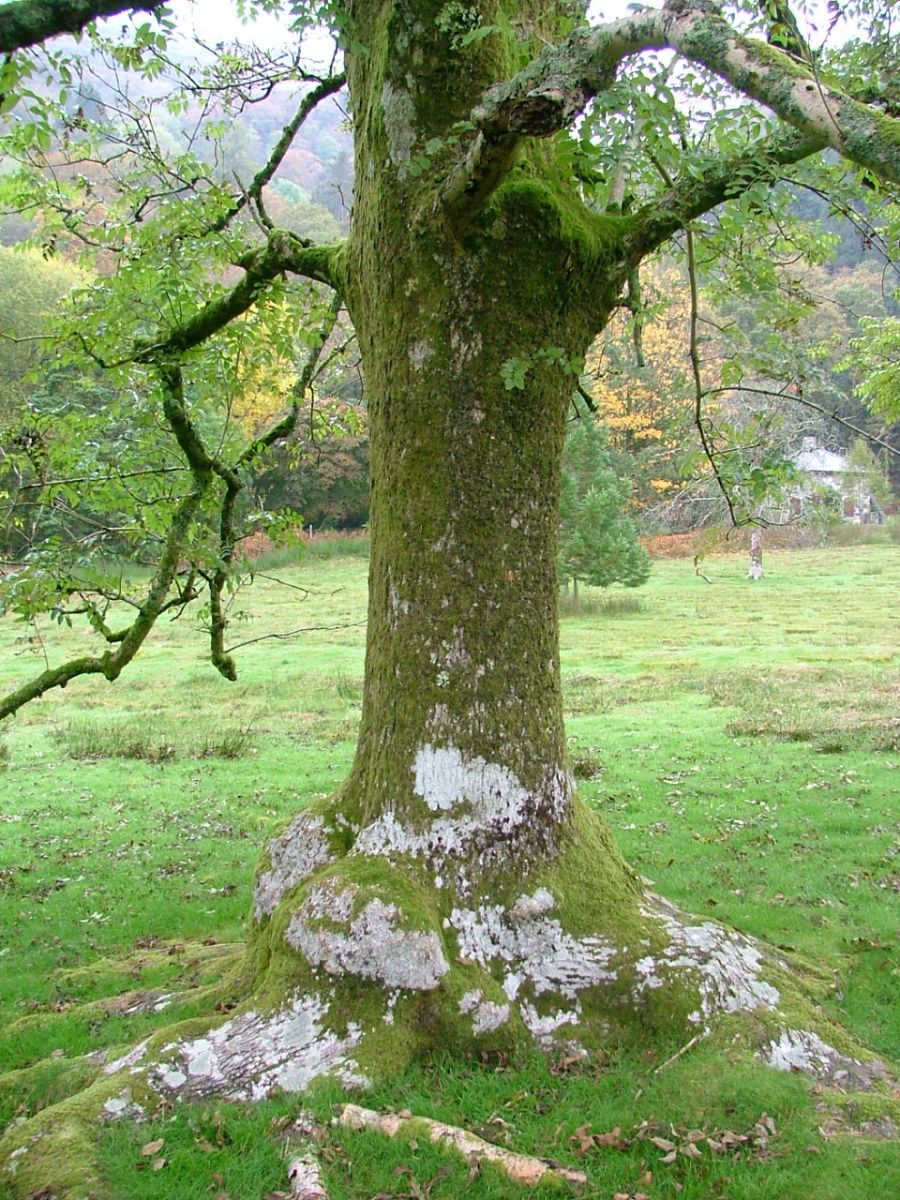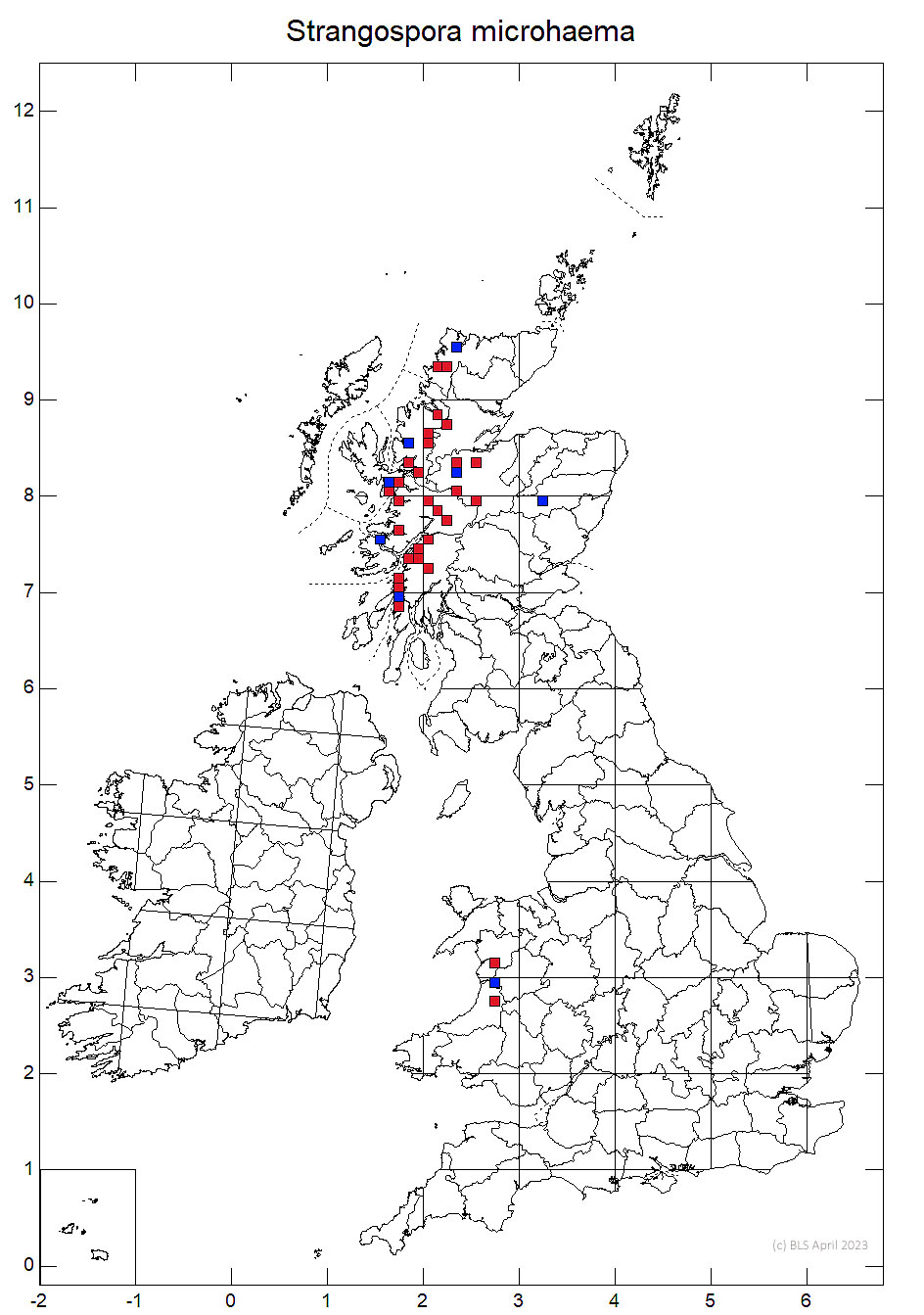Biatorella microhaema Norman (1865)
Wood Blood-clot lichen
This distinctive Lilliputian lichen has minute, c.0.05-0.2 (-0.3) mm diameter, coral to deep raspberry-red-coloured, bump-like, convex apothecia which are dispersed or loosely grouped over a filmy to slightly granular, indistinct thin grey-green crust. The apothecia are most apparent when semi-dry, becoming more translucent and lighter when saturated, though remaining detectable on account of their scarlet colour, and resemble specks of dried blood. Hardly visible to the unaided eye this lichen midget is best sought by systematically scanning suitable-looking mossy bark surfaces with x10 hand-lens.
Once known S.microhaema is unmistakeable and instantly recognisable, and could not be confused with any other lichen, except perhaps for Piccolia (formerly Strangospora) ochrophora, which has much larger, c. to 0.5mm diam., rusty-ochraceous, orange-pruinose, K+ purple (K- in S.microhaema), fragile apothecia, crumbling when prodded with a needle tip, and occurring on drier, base-rich bark. Biatoridium species have generally paler apothecia and a different layered structure to the ascus apex. Biatorella and Sarcosagium both have bacilliform ascospores and are terricolous. Microscopically S.microhaema has golden-reddish-orange hymenial tissues and its multispored asci, containing a frogspawn-like mass of simple, tiny, round ascospores, are similarly yellow-orange (-red) internally, as are the tips of the paraphyses. Prematurely released immature ascospores can also sometimes have orange contents.
S.microhaema lives on sodden, mossy, acid-barked deciduous trees in soggy oceanic-Atlantic woodland. Essentially a muscicolous species, it grows over thin wefts of pleurocarpous bryophytes, usually Hypnum andoi, on wet, rain-leached acid trunks and branches, in micro-niches similar to those selected by Gyalideopsis muscicola, but in slower-drying situations.
 |
In Britain S.microhaema is confined to boggy ancient woodland and wood-pasture in high rainfall areas in the west of Scotland, where it is local but probably still under-recorded on account of its size, and five trees between the three currently known sites in mid- and west Wales. In Scotland it is known from Alnus glutinosa, Fraxinus excelsior and Quercus, while in Wales it has been found on Fraxinus excelsior and Salix caprea. S.microhaema appears to be a specialist member of a hyperoceanic acidic facies of the Lobarion community sensu lato, having affinities to the Parmelion laevigatae.
S.microhaema was discovered new to Wales in 1994 in Cwm Llyfnant, v.c. 46, Cardiganshire (Chambers, 1994), since when it has been found at two more sites, a second site in Cardiganshire in the old walled garden at the Hafod estate and on an old Fraxinus excelsior in wood-pasture at Dol-y-cae at the foot of Cadair Idris in v.c. 48, Merionethshire. Being unobtrusive S.microhaema could well be overlooked in northwest Wales in suitable wet, old woodland and likely awaits discovery in v.c. 49 Caernarfonshire.
Cwm Llyfnant, v.c. 46, Cardiganshire: in small amount on ‘drip tassels’ of Hypnum andoi near the base of the trunk of a large old mossy maiden Fraxinus excelsior standing in a wet flush in woodland below the minor road on the S side of the valley at GR22(SN)719975, alt 80m, 8 June 1994, S.P.Chambers (Chambers, 1994). Confirmed by Dr B.J.Coppins. Voucher in Herb. SPC. The tree had good Lobarion elements, including Catinaria atropurpurea (abundant), Gyalideopsis muscicola (frequent), Megalaria pulverea (fertile), Sticta limbata (tiny, dying lobes) and Parmeliella triptophylla.
Hafod Walled Garden, v.c. 46, Cardiganshire: occupying c. 4 x 2cm of a Hypnum andoi mat, and closely associated with tufts of Lepraria rigidula, on the damp S side of an old Salix caprea trunk sheltered by close proximity of high garden wall, on the S side of the walled kitchen garden, Hafod Estate, E of Aberystwyth, GR22(SN)755731, alt 145m, November 1999, S.P.Chambers. Voucher in Herb. SPC. The tree also had fertile Megalaria pulverea. S.microhaema was re-found on the S side of the same tree against the S wall, apparently in unchanged abundance, in November 2006 (SPC). In October 2003 on a post-management work survey Ray Woods & Alan Orange found ‘several colonies’ of S.microhaema on two Ash trees by one of the Apple trees inside the garden. S.microhaema has been recorded on three separate trees therefore in the garden at this its most southerly British station. Ring counts from Ash trees thinned as part of management work in January 2000 supported by information from the current occupier (John Rainbow, pers. comm.) indicate the garden was last abandoned c. 1950-55 after a brief period of use following the end of WWII.
Ystradlyn, Dol-y-cae, v.c. 48, Merionethshire: locally frequent on thin wefts of Hypnum andoi, with frequent Parmeliella parvula, on the S to SE (mostly) and W sides of the trunk of an open-grown, freestanding, mature Fraxinus excelsior field tree, in a wood pasture-like setting close to ancient woodland fragments, at Ystradlyn, Dol-y-cae, near Cadair Idris, GR23(SH)729115, alt 100m, October 2009 (Chambers, 2010). Voucher in Herb. SPC. The tree stands in the middle of the sheep-grazed pasture fronting Dol-y-cae.
-
Loss of host trees from inadvertent or accidental felling, or for reasons of perceived health and safety, or from natural events, e.g. trees being blown down in storms.
-
Changes in bark characteristics (increased or decreased shade, alterations in moisture retention, drying, pH, nutrient-loading etc) from changes in site management, seral development and/or atmospheric pollutants.
-
On the Wales Lichen Red List S.microhaema is classed as Critically Endangered (CR, D) and on the British Red List as Near Threatened (NT) with Internationally Responsibility (IR). The species is also s.42 NERC listed.
Surveys of the three historic sites are needed to establish the current status of S.microhaema at each of them. At the Hafod Walled Garden site a phased management programme of pollarding and thinning work (Chambers, 1999) begun in 2000 was assessed by Ray Woods & Alan Orange in 2003, but a detailed re-survey is now required in order to ascertain medium-term effects of the management intervention on S.microhaema and the Lobarion assemblage in view of possible SSSI notification. Autecological information on the species is lacking, especially regarding population dynamics, turn-over and substrate relationships. The polysporous asci suggest the species is dispersal-adapted for locating dilute and specialised micro-niches within extensive woodland habitat. At the Hafod Walled Garden moss-sloughing was evident on the Salix trunk around the S.microhaema colony in 2000, but whether this constitutes a natural process, or is a consequence of dehumidification from the opening up of the garden, is unknown.
The Llyfnant site (v.c.46) is within the Cwm Llyfnant SSSI. The Dol-y-cae site (v.c.48) is outside the Cadair Idris NNR/SSSI but within the Snowdonia National Park (SNP) and SNP ecologists have been notified by CCW of its presence.
Chambers, S.P. (1994) In New, Interesting and Rare British Lichen Records, Bulletin of the British Lichen Society, No. 75, Winter 1994.
Chambers, S.P. (1999) Management Strategy and Work Plan for the Hafod Kitchen Garden pSSSI. Unpublished report, Countryside Council for Wales, Aberystwyth.
Chambers, S.P. (2010) In New, Interesting and Rare British Lichen & Lichenicolous Fungus Records, Bulletin of the British Lichen Society, No. 107, Winter 2010.
James, P.W., Duke, T. & Coppins, B.J. (2009) Strangospora. In The Lichens of Great Britain and Ireland (C.W.Smith, A.Aptroot, B.J.Coppins, A.Fletcher, O.L.Gilbert, P.W.James & P.A.Wolseley, eds): 867-869. London: British Lichen Society.
- Log in to post comments

